ID Codes
ID Codes

| Index | Rear Axle | Old ID Codes |
New ID Codes |
Engine Codes | Abbrevs | Links |
Email |
||
The large Toyota 2000GT of the late 1960's was a success but was it was too expensive to manufacture.
The small and cheaper S800 was also successful but only appealed to the outright enthusiast.
Toyota wanted a new sports car that would appeal to more average buyers.
It had to be easy to drive, practical and reliable.
The starting point of the Celica design was the EX-1 concept car. To this was added a combination of Corona and Corolla mechanical parts. Rear seats were also added to make it more practical - at least for small children.
EX-1 concept car.

Toyota also made a sedan called the Carina using the same floorplan, mechanicals and interior. By making 2 cars from the one design, Toyota saved a lot of money. This saving was then passed on to the customer. The Celica and the Carina were so similar that they were built on the same production line. This saved even more costs because only a single factory was needed to be built, not two.
So the Celica was release in Dec 1970 as Toyota's first mass produced sports car. At first there was only the coupe body style (also known as the hardtop). In Japan it came with 1400cc T and 1600cc 2T engines and had many options available. The option list went from the economical ET, to the LT and ST and up to the GT with the twincam engine and sports suspension. America had the 1900cc 8R in the 4 speed manual ST only. Australia only had the 1600cc TA22 LT. Most other countries had the 1600cc TA22 ST and GT as the only models. It is possible to convert T engined cars to be R engined and vice-versa by replacing the crossmember, gearbox and driveshaft from the equivalent model.
Tyre testing.

Cold testing.
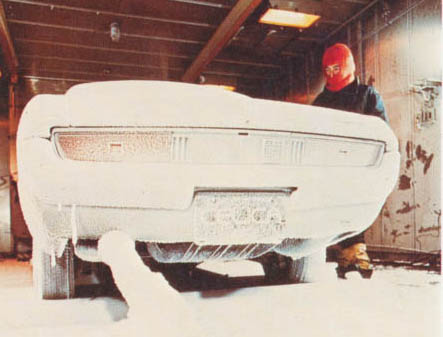
Celica Production Line.
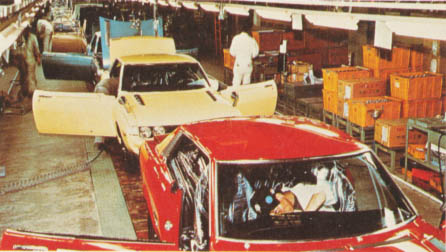
The orginal 1900cc RA20 was replaced by the 2000cc RA21 with the 18R-C engine. It had the same limited options as before.
The fuel tank was moved from under the boot (trunk) to behind the rear seat. It was hoped that this would prevent explosions in rear collisions. The fuel filler was also moved from the rear panel to the C pillar.
The American models were expanded to include an automatic gearbox.
The UK models were expanded to include the 1600cc twincam GT with LSD.
The GTV was introduced in Japan as an alternative to the GT. It could be ordered with less trim options than the GT, so it could be lighter and more suitable as a racer. Mechanically it was identical to the Japanese GT except for lower and stiffer suspension.
1972 EX-7

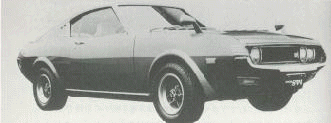
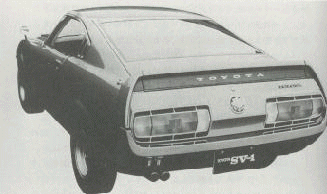
In early 1973 a liftback prototype called the SV1 was built (pictures above and below).
It was not sold to the public.
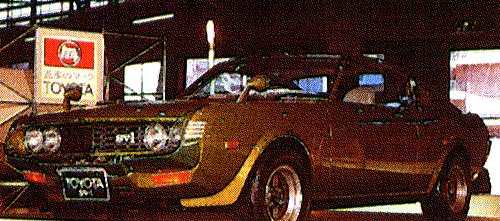
The RA25 and TA27 liftbacks were released in April 1973 and had a new look nose (the SV1 had the old nose slightly modified). The new liftback looked so similar to the 1969 Ford Mustang fastback that the Celica liftbacks are often called the "Mustang style". The earlier interior and mechanicals were retained. There were 5 narrow tail lights each side. Liftbacks after Oct 1975 had 3 wider tail lights each side (more like the Mustang) but the 2 types of lights are interchangeable. The TA27 was similar to the RA25 except for the engine and gearbox. The TA27 had a 2T engine and a T40 or T50 gearbox. The RA25 had an 18R engine and a W40, W50 or P51 gearbox. The liftback was only sold in Japan and some parts of Europe.
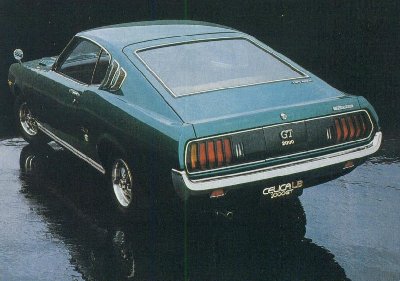 RA25
RA25

The RA21 coupe was also introduced. It was the same as the TA20 and TA22 coupes except that it had the 18R engine. All coupes continued to use the old style nose until Jan 1974.
The RA21 coupe was also released in America with the old style nose and the 18R-C engine. The American models were expanded to include the LT and GT models. America was the only market to have an automatic GT. However, it was also the only market where the GT didn't have a twincam engine - just the stock 18R-C. s
The wheel arches were flared a bit more to make the whole car wider. No mechanical or structural changes occured. The American RA21 was replaced by the 2200cc RA22 with the 20R engine. The taller engine required a new cross member and a power bulge in the bonnet. Americans usually call this the '75 model due to their weird numbering scheme.
The JDM coupe received the same nose as the JDM liftback in Jan 1974. Other markets continued with the original nose until Oct 1975. The JDM nose is shorter than the nose used after Oct 1975 and they can not be interchanged. The JDM nose can be retro fitted to overseas models before Oct 1975 since they used the same wheelbase.
In 1975 the entire range was revised. All models now had a lengthened version of the JDM nose with slightly different front bumpers and front indicators. While the JDM nose had a flat bonnet, the new models had a bonnet with a large bulge. Doors remained the same and are interchangeable between all 1970-1977 models but the door glass is different between coupes and liftbacks. The front chassis rails where lengthened a bit to improve weight bias (centre of engine now slightly behind the front wheels). Chassis width was also increased slightly but the body was the same width.
Most world markets received the TA23 or RA23 coupes and the RA28 liftback.
The RA24 was the American version of the RA23. The RA29 was the American version of the RA28. They had very ugly large safety bumpers and very restrictive pollution control on 2200cc 20R engines. The saftey bumpers were also available as an option on Japanese cars. American cars also had extra side lights just behind the rear wheels.
Japan struggled with emmission control laws, so in 1976 the 23 and 28 were replaced by the 35 for both coupe and liftback models. Some of this technology was bought from Honda (TTC-V).
'76-'77 RA29 (below)
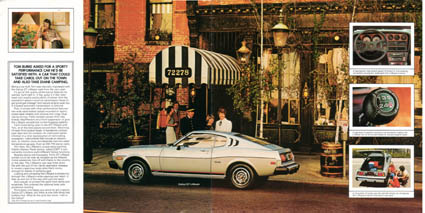
Hyper-thetical '76-'77 Supra (below)
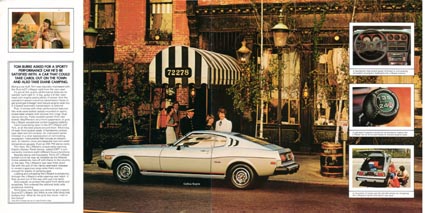
Hyper-thetical '76-'77 4 door liftback (below)

Hyper-thetical '76-'77 wagon (below)
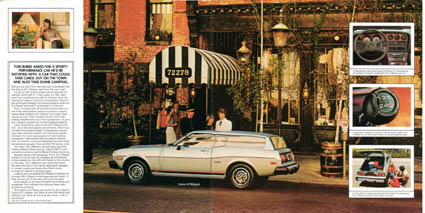
Hyper-thetical '76-'77 off road (below)
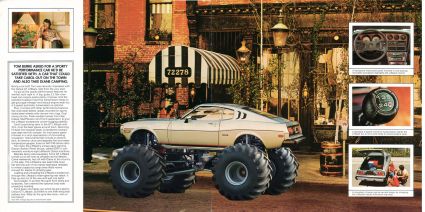
Hyper-thetical '71 targa top (below)

New model with completely new sheet metal. Engine cross member (engine cradle) and all front suspension parts still interchange with 1975-1977 models.
Celica Supra introduced with the 6 cylinder 4M engine. The nose and front chassis were stretched to allow for this larger engine. In Japan this model was called the Celica XX.
Celica Camry introduced in Asian markets. It had Carina sheet metal with a slightly better option list and including independant rear suspension. The next Camry became a model in its own right separate from the Celica.
America had the Sunchaser, TX22 and Legato as officially supported convertible and targa roof conversions done by the local company "Griffith". Griffith also converted a number of UK models for the UK market - conversions based on the UK GT had twincam engines.
All Celica, Celica Supra, Celica XX, Celica Camry and Carina models now designated by the new code system.
Front sheet metal, lights and trim revised (not interchangeable with old style). Dashboard revised.
Supra upgraded to 5M engine.
To get rid of stock, America had a limited edition (5000 units) GTA using trim and wheels from the Cressida. It still had the single cam engine though.
New wedge shape.
Celica XX adds 2000cc 1M and 1G engines in normal and turbo forms.
Last updated 22 Mar 2008